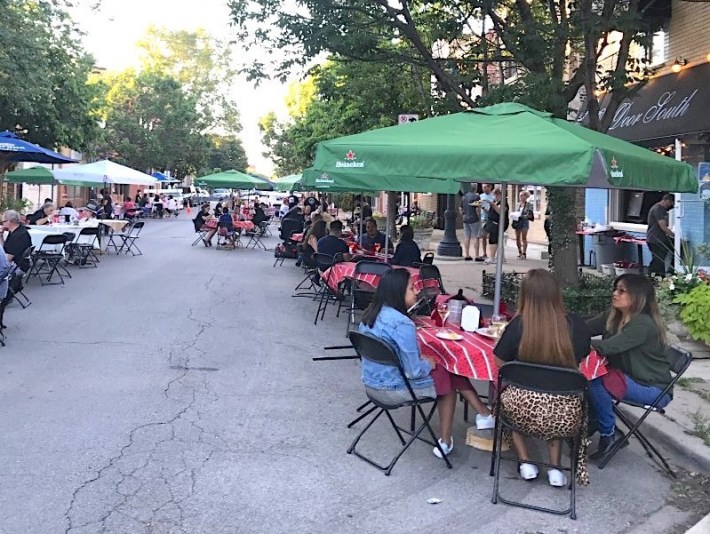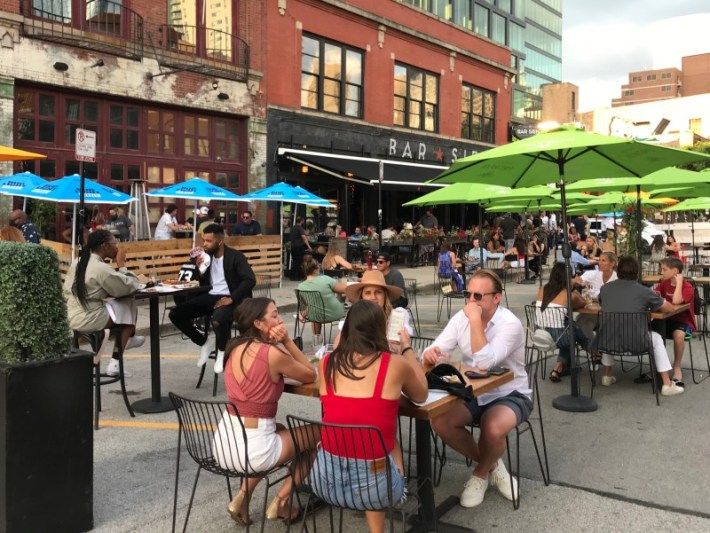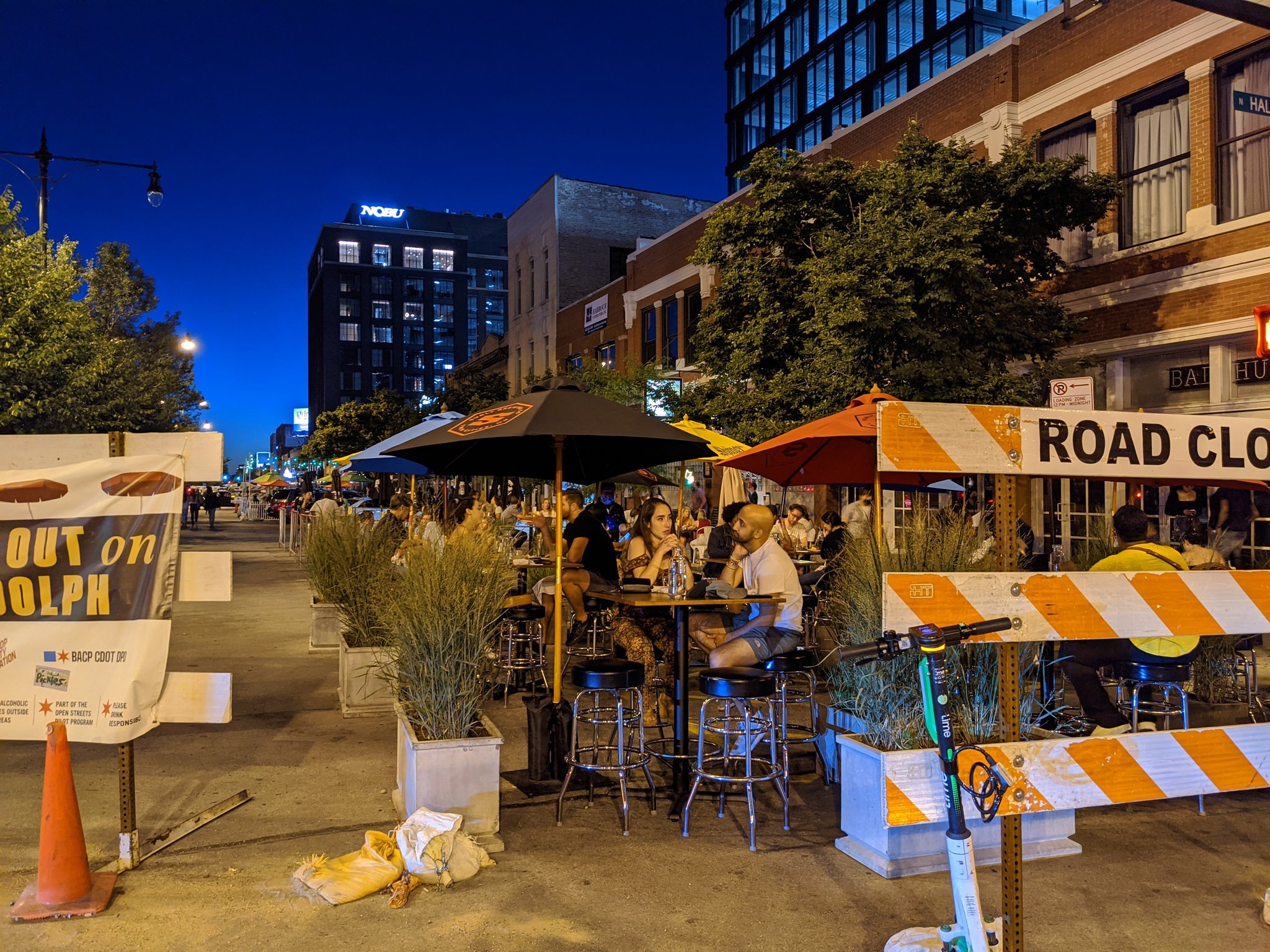One silver lining to the COVID crisis is that the need for more room for social distancing has motivated city leaders to rethink the default practices of dedicating a maximum amount of public space to moving and storing motor vehicles. Other U.S. cities have converted travel and parking lanes to emergency bus lanes (which reduce trip times and the risk of COVID exposure) and bike lanes, and created large scale networks of Slow Streets, residential roadways where through traffic has been banned.
Chicago has failed to do much on those fronts, save for establishing a handful of mostly unconnected Slow Streets. But one coronavirus public space intervention initiative that our city has wholeheartedly embraced, likely because it's helping to save jobs and generate tax revenue, is Cafe Streets, pedestrianizing roadways for socially-distanced outdoor dining and drinking. (The city calls the program "Make Way for Dining.")
I'll leave it up to public health officials to determine whether Cafe Streets have been successful from an epidemiological standpoint (They certainly must be a more COVID-safe option than indoor dining and drinking, which Chicago is also allowing, although beaches have been closed all summer.)

But in terms of helping the local economy, and creating vibrant street life during a time when there are limited options for entertainment outside of one's home, Chicago's Cafe Streets seem to be a runaway success. Business appears to be booming at the cafe streets established on many of our city's bustling restaurant strips. Mayor Lori Lightfoot appears to appreciate the value of outdoor dining for helping our city weather the crisis -- she recently launched a contest with a $5,000 prize to brainstorm ideas for facilitating outside service during the colder months.
Unfortunately, so far none of Chicago's predominantly Black- and Latino-owned restaurants strips have reaped the benefits of Cafe Streets, due to concerns from some merchants and community leaders that pedestrianizing streets would be bad for business. On the bright side, Chatham's iconic 75th Street dining district, one of the corridors where plans for a fully-pedestrianized Cafe Street were scrapped, is opening the 75th Street Boardwalk this Saturday, with parking spaces converted to on-street seating space.
Commissioner Cox and DPD staff toured 75th Street in Chatham on Friday, where restaurateurs are preparing to open the 75th Street Boardwalk, a series of unique outdoor dining experiences. Join for the ribbon cutting this Saturday, Sept. 5 at 3:30 p.m. https://t.co/IV4297EWmD pic.twitter.com/2e5DZxXtep
— Chicago DPD (@ChicagoDPD) August 31, 2020
The latest Cafe Streets success story is the trendy Fulton Market district in the West Loop. While Chicago street openings for outdoor dining have generally only happened on weekends, the program has been so successful on Fulton that it's recently been expanded to seven days a week, from 11 a.m. to 11 p.m, between Sangamon and Morgan streets, and between Halsted and Peoria streets, Block Club Chicago's Mauricio Peña reported. Short stretches of Peoria and Sangamon are also opened for dining. (The bustling Randolph Street strip, two blocks south, has also had its service drives, although not the main travel lanes, pedestrianized for outdoor dining seven days a week.)

Streetsblog photo contributor Eric Allix Rogers raised an obvious point. Since pedestrianized dining districts are so economically successful and vibrant, and so much more pleasant than the normal car-choked situation, why don't we make them permanent?
👏 Make 👏 this 👏 permanent! 👏 River North & the West Loop are among my least favorite parts of town, but seeing this made clear that my actual problem is with the oppressive, noisy, smoggy, dangerous, relentless presence of cars, which ruin everything. #bancars pic.twitter.com/WXP7QtM6cy
— Eric Allix Rogers (@EricAllixRogers) August 30, 2020
At least during the warmer months, and possibly year-round, almost all of Chicago's successful Cafe Streets would be good candidates for 24-7 pedestrianization. Here's the full list as of July 31, although the street openings have popped up in a few other locations since then.
- Andersonville: W. Balmoral St. both sides of N. Clark St.
- Chatham: E. 75th Ave. from S. Calumet Ave. to S. Indiana Ave.
- Chinatown: S. Archer Ave from S. Wentworth Ave to S. Princeton Ave. (within the Chinatown Place shopping arcade)
- East Rogers Park: 1500 to 1524 W. Jarvis Ave.
- Edison Park: N Oliphant Ave from Northwest Highway to the first alley
- Lakeview: 3200-3300 N. Sheffield Ave.
- Lincoln Park: N. Lincoln Ave. from W. Fullerton Ave. to W. Wrightwood Ave.
- Little Italy: W Taylor St from S Loomis St to S Ashland Ave; S Laflin St from the alley north of W Taylor St to the alley south of W Taylor St
- Lower West Side: S. Oakley Blvd. from W. 24th St. to W. 24 Pl.
- Roscoe Village: W. Roscoe St. from N. Seeley Ave. to Damen Ave.
- Rush & Division: N. Rush St. from E. Oak St. to E. Cedar St., E. Bellevue Pl. from N. State St. to the first alley east of N. Rush St. and W. Division St from N. Dearborn St. to N. State St.
- West Lakeview: W. Cornelia Ave. from N. Southport Ave. east to the alley and N. Paulina St. from N. Southport Ave. south to the alley.
- West Loop: W. Randolph St. service lanes from the Kennedy Expressway to N. Elizabeth St.
Which would be your top choices for pedestrianized dining and shopping zones (including streets that aren't on the above list)? Let us know in the comments.
Follow John Greenfield on Twitter at @greenfieldjohn.





